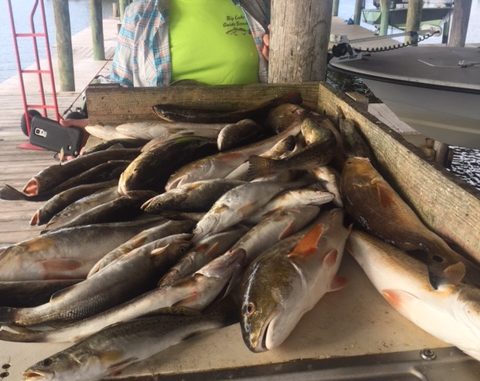
Big Lake holds big promise for the new year
January is a time to shine for the Calcasieu Lake are, and no one knows that better than Jeff Poe, who along with wife Mary and son Nick own Big Lake Guide Service.
Anglers can catch trout shallow when it’s very cold in January, especially when wading, Poe said.
Or they can catch fish deep, he said.
Poe opted to discuss the latter, specifically targeting the Industrial Canal. It’s a hotspot for the coldest of days. In fact, the colder it gets the more boats that are in there probing the depths for speckled trout.
To get there from Calcasieu Lake, just travel north in the Ship Channel and turn east at the Intracoastal Waterway, he said. After less than a mile, veer northeast into the canal that is home to several industries, including Trunkline, Leevac Shipyards and the LNG Plant.
Poe said it’s a deep dead-end canal that fills up with speckled trout in the dead of winter for several reasons.
“It stacks a lot of bait in there and, being a dead-end canal, it attracts fish because they don’t have to fight the current,” he explained. “It’s dredged 45 feet deep.”
You just have to work the canal until you locate them, the gide said.
“If there’s not a lot of ship action, the fish can be anywhere in it, bank to bank,” Poe said. “I’ve caught them in there when it’s freezing cold, cold.”
He said has had bites as soon as his soft plastic hits the water despite the extremely low temperature. That can happen after the sun’s been out a few days and the water near the surface warms up.
Much of the time, however, if the speckled trout aren’t near the top, they are 10- to 25-feet deep, he said.
Most of the time the fish are suspended but, occasionally, they are on the bottom.
“You have to work a lot of water vertically, and you have to remember (the depth of) the first bite,” Poe said. “It could be in the middle of nowhere.
“If you work it on the bottom, don’t hop it: Just barely drag it. When they hit, occasionally you’ll get a tap, but most of the time it’s a subtle bite.”
Fish along the shoreline, for sure, he said, because more often than not that’s where the action is.
However, stay out of the “safety zones” established by the U.S. Coast Guard since 9/11 around the LNG Plant.
“You must stay so many feet off the bank,” he said, adding that, unfortunately, those specific areas used to give up beau coup speckled trout.
The main meal tickets to get the fish in the ice chest are soft plastics such as H&H Cocahoes and Sparkle Beetles and Lil Johns, Poe said. Smaller-profile baits often work the best, he said.
What color? Mostly avocados, glows and chartreuses, he said, adding that sometimes the wilder colors produce in the wintertime.
Best options for jigheads are 1/8-ounce models. Anglers can get away with such a light leadhead because there’s little, if any, current.
Poe said he prefers either 15-pound braided line or 10-pound fluorocarbon. He really favors the fluorocarbon line when trout are deep because it helps keep the soft plastic down.
“Flourocarbon, if they’re on the bottom, is hard to beat,” he said.
Braided line aids in keeping a soft plastic in the strike zone when targeting suspended fish because of its buoyancy.